
Typee: A Peep at Polynesian Life is American writer Herman Melville's first book, published in 1846, when Melville was 26 years old. Considered a classic in travel and adventure literature, the narrative is based on Melville's experiences on the island Nuku Hiva in the South Pacific Marquesas Islands in 1842, supplemented with imaginative reconstruction and research from other books. The title comes from the valley of Taipivai, once known as Taipi.

Omoo: A Narrative of Adventures in the South Seas is the second book by American writer Herman Melville, first published in London in 1847, and a sequel to his first South Sea narrative Typee, also based on the author's experiences in the South Pacific. After leaving the island of Nuku Hiva, the main character ships aboard a whaling vessel that makes its way to Tahiti, after which there is a mutiny and a third of the crew are imprisoned on Tahiti. In 1949, the novel was adapted into the exploitation film Omoo-Omoo, the Shark God.
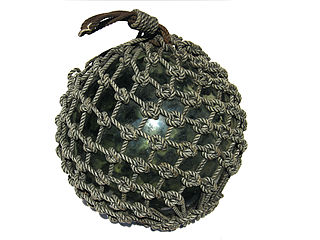
Glass floats, glass fishing floats, or Japanese glass fishing floats are popular collectors' items. They were once used by fishermen in many parts of the world to keep their fishing nets, as well as longlines or droplines, afloat.
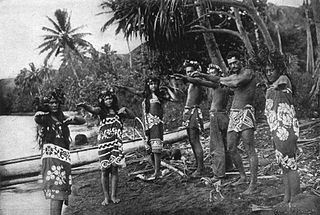
The Marquesas Islands were colonized by seafaring Polynesians as early as 300 AD, thought to originate from Samoa. The dense population was concentrated in the narrow valleys and consisted of warring tribes.
Located in the central Pacific Ocean, Fiji's geography has made it both a destination and a crossroads for migrations for many centuries.
Palagi or papalagi (plural) is a term in Samoan culture of uncertain etymology, sometimes used to describe foreigners.
"The Encantadas, or Enchanted Isles", is a novella by American author Herman Melville. First published in Putnam's Magazine in 1854, it consists of eleven philosophical "Sketches" on the Galápagos Islands, then frequently known as the "Enchanted Islands" from the treatcherous winds and currents around them. It was collected in The Piazza Tales in 1856. The Encantadas was a success with the critics and contains some of Melville's "most memorable prose".

A grass skirt is a costume and garment made with layers of plant fibres such as grasses and leaves that is fastened at the waistline.
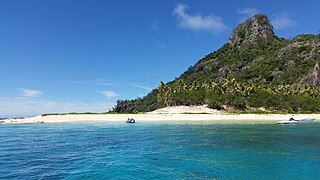
Monuriki is a small, uninhabited island situated off the coast of Viti Levu in the Fiji Islands, in Melanesia in the South Pacific Ocean. Monuriki is part of the Atolls islands, and related to a group of three islets in the larger group of islands known as the Mamanuca Islands. This coral and volcanic island is the smallest islet and the southernmost of a small group of three islets, west of Tavua.
Tai Pī is a province of Nuku Hiva, in the Marquesas Islands, an administrative subdivision of French Polynesia. The settlement follows the line of the valley and the stream that passes from its mountainous island surroundings.

Polynesia is a subregion of Oceania, made up of more than 1000 islands scattered over the central and southern Pacific Ocean. The indigenous people who inhabit the islands of Polynesia are called Polynesians. They have many things in common, including language relatedness, cultural practices, and traditional beliefs. In centuries past, they had a strong shared tradition of sailing and using stars to navigate at night. The largest country in Polynesia is New Zealand.

Enchanted Island is a 1958 American Technicolor adventure film distributed by Warner Bros., directed by Allan Dwan, produced by Benedict Bogeaus, and written by Harold Jacob Smith, James Leicester, and Al Stillman. It is based on Herman Melville's novel Typee, which was also the film's working title. The title song, "Enchanted Island", written by Stillman and Robert Allen, was performed on the soundtrack by The Four Lads, who had a hit recording of the song on Columbia Records.
Charles Savage, was a sailor and beachcomber known for his exploits on the islands of Fiji between 1808 and 1813.

The Peʻa is the popular name of the traditional male tatau (tattoo) of Samoa, also known as the malofie. It is a common mistake for people to refer to the pe'a as sogaimiti, because sogaimiti refers to the man with the pe'a and not the pe'a itself. It covers the body from the middle of the back to the knees, and consists of heavy black lines, arrows, and dots.
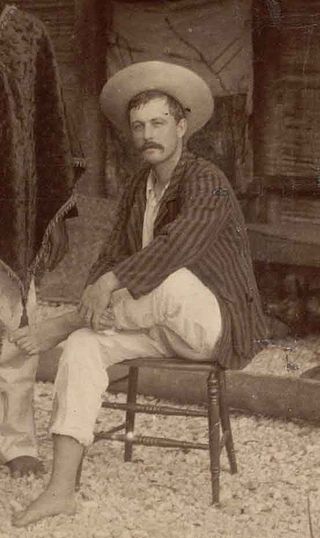
John Wilberforce "Jack" Buckland (1864–1897), also known as "Tin Jack", was a trader who lived in the South Pacific in the late 19th century. He travelled with Robert Louis Stevenson and his stories of life as an island trader became the inspiration for the character of Tommy Hadden in The Wrecker (1892).
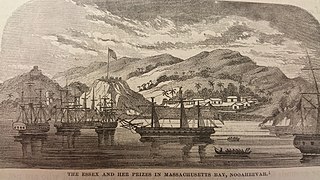
The Nuku Hiva Campaign was an armed conflict between the United States and the Polynesian inhabitants of Nuku Hiva during the War of 1812. It occurred in 1813, following Captain David Porter's decision to sail his fleet to the island for repairs before continuing his raid against British shipping. Upon arrival, the Americans became involved in a tribal war and allied themselves with the Te I'i people against the Happah and Tai Pi clans.
Paul Gauguin Cruises is a cruise line that was owned by Beachcomber Croisieres Limited until 2019, when it was purchased by French company Compagnie du Ponant. Paul Gauguin Cruises operates cruises with one ship, the Paul Gauguin, to Tahiti, French Polynesia and the South Pacific.
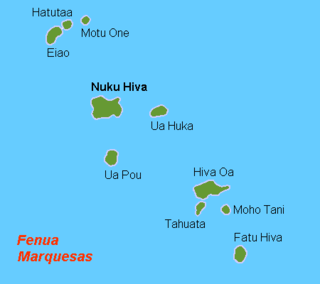
Nuku Hiva is the largest of the Marquesas Islands in French Polynesia, an overseas country of France in the Pacific Ocean. It was formerly also known as Île Marchand and Madison Island.
David Whippey was an American sailor from Nantucket who became a "beachcomber", a white resident of the Fijian islands who served as liaison between the local and foreign communities, and eventually was the United States vice-consul to Fiji.

The Marquesan Dog or Marquesas Islands Dog is an extinct breed of dog from the Marquesas Islands. Similar to other strains of Polynesian dogs, it was introduced to the Marquesas by the ancestors of the Polynesian people during their migrations. Serving as a tribal totems and religious symbols, they were sometimes consumed as meat although less frequently than in other parts of the Pacific because of their scarcity. These native dogs are thought to have become extinct before the arrival of Europeans, who did not record their presence on the islands. Petroglyphic representations of dogs and the archaeological remains of dog bones and burials are the only evidence that the breed ever existed. Modern dog populations on the island are the descendants of foreign breeds later reintroduced in the 19th century as companions for European settlers.















